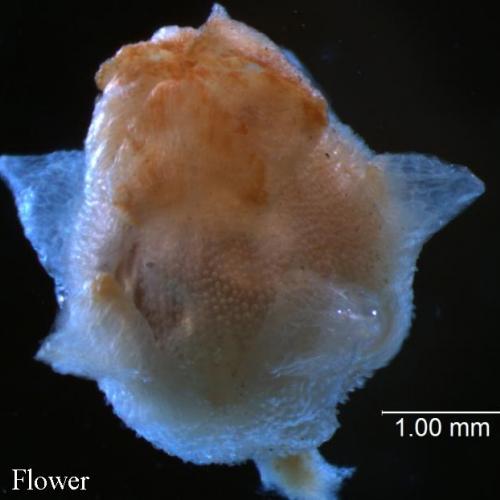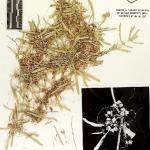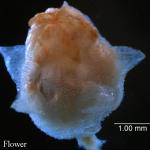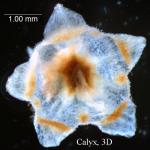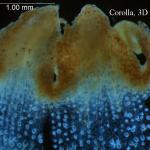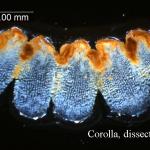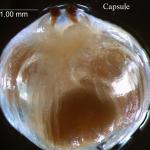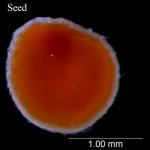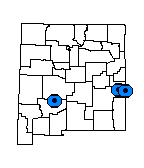Description
Twining, tangled, yellow threadlike annual with stems 0.5 mm or less in diameter; inflorescence a glomerule of subsessile flowers on glabrous pedicels; flowers 5-merous, 2.1-4 mm long, slightly fleshy; calyx campanulate-cupulate, about 1/2 the corolla length, divided about 1/2 its length into triangular-ovate lobes, each apically enlarged to form a large, prominent, divergent, horn-like projection 0.5-0.75 mm long; corolla tube campanulate-urceolate, 1.7-2.5 mm long, the lobes triangular, more or less auriculate, acute, 0.5-0.7 mm long, 1/3-1/4 the corolla length, suberect, apically inflexed and basally overlapping; stamens included, incurved over the ovary; infrastaminal scales about reaching the filaments, united with the corolla tube for about 1/2 their length, oblong, shallowly and irregularly toothed at the truncate apex; styles distinct, 0.2-0.4 mm long, evenly filiform, barely longer than the collar-like stylopodium, the stigmas globose, capitate; capsules semi-transparent when dry, more or less papillose, globose, 0.9-1.2 mm long, indehiscent or irregularly dehiscent, enveloped by the corolla, the suture line between the two carpels not depressed, apical region of capsule thickened and raised around the style-base; seeds 2 per capsule. Flowers in September.
Similar Species
All dodders are superficially similar, appearing as yellow or yellow-orange piles of string on the vegetation. Cuscuta warneri has the following combination of characters that distinguishes it from other dodders: fleshy, papillose flowers, corolla lobes with inflexed tips, capsules with a thickened ring at apex, the styles short and the stigmas barely projecting beyond ring; calyx lobes with apical thickened spur-like projections; infrastaminal scales shallowly and irregularly toothed at truncate apex.
Distribution
New Mexico, Sierra and Roosevelt counties; Utah, Millard County; possibly Arizona, Coconino County.
Habitat
Grows on Phyla in open wet areas that support the host species; 1,430-1,460 m (4,700-4,800 ft).
Conservation Considerations
Dodders (Cuscuta spp.) are serious pests of some crops and subject to eradication when they occur in or near agricultural fields. Attempts to identify the particular species being eradicated are almost never made. Almost nothing is known about the natural history of this species. Attempts should be made to relocate the Cuscuta warneri population in New Mexico to determine general habitat, hosts, frequency of plants and extent of the population. Similar habitats then should be searched.
Important Literature
Correll, D.S. and H.B. Correll. 1972. Aquatic and wetland plants of southwestern United States. U.S. Government Printing Office, Washington, DC.
*Costea, M., G.L. Nesom, S. Stefanović. 2006. Taxonomy of the Cuscuta indecora (Convolvulaceae) complex in North America. Sida 22:209-225. (Scanning electron micrographs of flower and capsule.)
*Yuncker, T.G. 1960. Two new species of Cuscuta from North America. Brittonia 12:38-40. (Line drawing of flower and capsule.)
